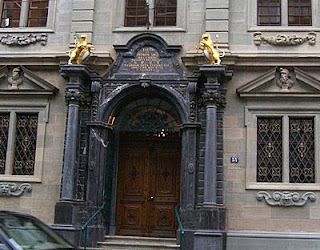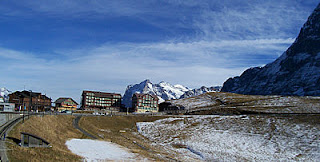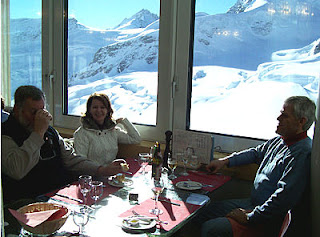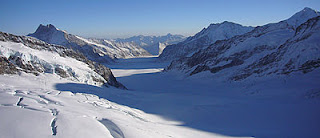On Monday morning, 4 December 2007, we joined a bus tour group, to see the main historic places of Paris. The tour went something like this, starting off in the pouring rain, past the following places:
 |
| Academie Nationale de Musique. |
The Paris Opera House (Academie Nationale de Musique) stands at the beginning of the Boulevard des Capucines, was designed by architect Charles Garnier and built between 1862 and 1875. It is the largest theatre for lyric opera in the world and can accommodate an audience of 2000 and 450 performers on stage.
The Galleries Lafayette – the huge, famous department store at the junction of Boulevard Hausmann and Rue Lafayette, just behind the Opera house.
When the old part of Paris was built - the "golden triangle" - the city planners decreed that all buildings should have the same height, five stories, with a similar appearance. All have balconies with wrought-iron railings all have the same pale stone cladding. This made for a very neat-looking city, as is evident from the photo above. Note the similarity between the buildings on either side of the Opera House.
When the old part of Paris was built - the "golden triangle" - the city planners decreed that all buildings should have the same height, five stories, with a similar appearance. All have balconies with wrought-iron railings all have the same pale stone cladding. This made for a very neat-looking city, as is evident from the photo above. Note the similarity between the buildings on either side of the Opera House.
The Place Vendôme is a vast architectural complex dating from the time of Louis XIV, built between 1687 and 1720. The octagonal square is surrounded by buildings which have large arcades on the ground floor, housing mostly the famous jewellery houses like Boucheron, Van Cleef and Arpels, Mikimoto, Bulgari, Buccellati and many others. Today at number 15 is the famous Hotel Ritz and at number 12 is the house where Chopin died in 1847.
In the centre of the square is the column erected by Gondouin and Lepère between 1806 and 1810 in honour of Napoleon I. Inspired by the Column of Trajan in Rome, it is 43.5 metres high with, around its shaft, a spiraling series of bronze bas-reliefs cast from the 1,200 cannon captured at Austerlitz. On top of the column stands a copy of the original statue of the Emperor dressed as Ceasar, by Chaudet.
In the centre of the square is the column erected by Gondouin and Lepère between 1806 and 1810 in honour of Napoleon I. Inspired by the Column of Trajan in Rome, it is 43.5 metres high with, around its shaft, a spiraling series of bronze bas-reliefs cast from the 1,200 cannon captured at Austerlitz. On top of the column stands a copy of the original statue of the Emperor dressed as Ceasar, by Chaudet.
The Rue de la Paix extends from the Place Vendôme towards the Opera House. This street is equally famous for its shops, for example Cartier, the world's best-known jeweller, he who the English king Edward VII defined as 'the jeweller of kings, the king of jewellers'.
From there the bus travelled along the Avenue de l'Opera towards the Louvre and along the right bank of the Seine past the Louvre and the French Academy. The Academy is the pre-eminent French learned body on matters pertaining to the French language. The Academy was officially established in 1635 by Cardinal Richelieu, the chief minister to King Louis XIII.
From there we crossed the river at the Pont Neuf (New Bridge), which is the oldest bridge still in use in Paris. It was the first bridge built in stone and not of wood. Standing by the western point of the Île de la Cité, the island in the middle of the river that was the heart of medieval Paris, it connects the left bank (Rive Gauche) of the River Seine with the right bank (Rive Droite). The decision to build the bridge was made by King Henri III, who laid its first stone in 1578. It was completed under the reign of Henri IV, who inaugurated it in 1607.




















































